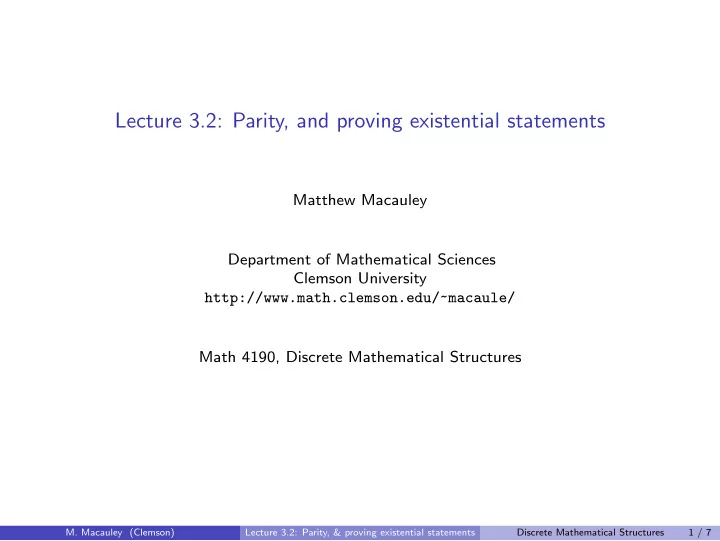

Lecture 3.2: Parity, and proving existential statements Matthew Macauley Department of Mathematical Sciences Clemson University http://www.math.clemson.edu/~macaule/ Math 4190, Discrete Mathematical Structures M. Macauley (Clemson) Lecture 3.2: Parity, & proving existential statements Discrete Mathematical Structures 1 / 7
Overview Definition An integer n is: even iff ∃ k ∈ Z such that n = 2 k , odd iff ∃ k ∈ Z such that n = 2 k + 1, prime iff n > 1 and ∀ a , b ∈ Z + , if n = ab , then n = a or n = b . composite iff n > 1 and n = ab for some integers 1 < a , b < n . Examples Let’s think about what would be needed to establish the following statements. 1. (Proving ∃ ). Show that there exists an even integer that can be written as a sum of two prime numbers in two ways. 2. (Disproving ∃ ). Show that there does not exist a , b , c ∈ Z , and n > 2 such that a n + b n = c n . 3. (Proving ∀ ). Show that “2 2 n + 1 is prime, ∀ n ”. 4. (Disproving ∀ ). Show that the statement “2 2 n + 1 is prime, ∀ n ” is actually false. In this lecture, we’ll focus on parity (even vs. odd), and proving existential statements. M. Macauley (Clemson) Lecture 3.2: Parity, & proving existential statements Discrete Mathematical Structures 2 / 7
Proving an existential statement A statement such as ∃ x ∈ U such that Q ( x ) is true iff Q ( x ) is true for at least one x ∈ U . There are several ways to prove such a statement: 1. Constructively: find or construct such an x . 2. Non-constructively: show that such an x must exist, by an axiom, theorem, or other means. 3. Indirectly: by contrapositive or contradiction. M. Macauley (Clemson) Lecture 3.2: Parity, & proving existential statements Discrete Mathematical Structures 3 / 7
Examples of constructive proofs Proposition There exists an integer that can be written as a sum of two prime numbers in two ways. Proof We’ll find such an integer. Note that 10 = 5 + 5 = 3 + 7 . � Proposition Let n and m be odd integers. Then n + m is even, i.e., n + m = 2 k for some k ∈ Z . Proof We’ll construct a way to write n + m = 2 k . First, write n = 2 a + 1 and m = 2 b + 1 for some a , b ∈ Z . Note that n + m = (2 a + 1) + (2 b + 1) = 2( a + b ) + 2 = 2( a + b + 1), hence n + m is even. � M. Macauley (Clemson) Lecture 3.2: Parity, & proving existential statements Discrete Mathematical Structures 4 / 7
Examples of non-constructive and indirect proofs Proposition There exist irrational numbers x , y ∈ R such that x y is rational. Proof √ √ √ 2 is rational, we’re done. (Let x = y = If 2 2). √ √ √ √ 2 is irrational, let x = √ 2 and y = If 2 2 2. Note that √ √ √ √ √ 2 = 2 . x y = ( 2 ) √ 2 = 2 · 2 2 � Proposition Prove that if 5 n + 2 is odd, then n is odd. Proof (by contrapositive) Suppose that n is even, i.e., n = 2 k . Then 5 n + 2 = 5(2 k ) + 2 = 2(5 k + 1) is even. � M. Macauley (Clemson) Lecture 3.2: Parity, & proving existential statements Discrete Mathematical Structures 5 / 7
More practice Proposition An integer n is even if and only if n + 1 is odd. Proof M. Macauley (Clemson) Lecture 3.2: Parity, & proving existential statements Discrete Mathematical Structures 6 / 7
Disproving existential statements To disprove an existential statement, ∃ x ∈ U such that Q ( x ) , we have to show that ∀ x ∈ U , ¬ Q ( x ) , i.e., prove a universal statement. This will be the focus of the next lecture. We’ve actually done a few of these already. For example, rephrasing an earlier result: Proposition For all odd integers n and m , the sum n + m is even. M. Macauley (Clemson) Lecture 3.2: Parity, & proving existential statements Discrete Mathematical Structures 7 / 7
Recommend
More recommend